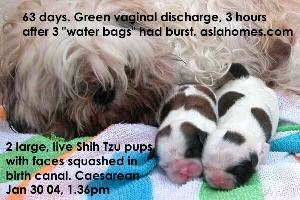"I need a
Caesarean after I have washed the
kennels," the breeder said. "My Schnauzer
has not been able to give birth for the
past 3 hours." It was nearly 4 pm on
this drizzling Sunday afternoon and I had
an appointment to see "The Last Samurai"
at 6.05 pm at the Bishan Cinemaplex.
It was said to be an excellent movie.
The breeder seldom had Caesareans and he
attributed that to his top quality vitamin
and mineral supplementation.
Actually Caesareans are very rare for all
professional canine breeders served by me.
Less than 1% of births. But when
they occur, it could be anytime before and
after midnight too and at inconvenient
hours.
 "If you want live
puppies, rush over now!" I advised. "Stop all
work and get a taxi if you don't have a car. I
hate delivering dead puppies." I am sure all
vets dislike that too. Dystocias
(difficult births) are emergencies but some
breeders don't think that way. In the
end, they pay the vet bill and still receive
dead puppies or a dead bitch too. "If you want live
puppies, rush over now!" I advised. "Stop all
work and get a taxi if you don't have a car. I
hate delivering dead puppies." I am sure all
vets dislike that too. Dystocias
(difficult births) are emergencies but some
breeders don't think that way. In the
end, they pay the vet bill and still receive
dead puppies or a dead bitch too.
The breeder took
over 30 minutes to arrive. The fat
Schnauzer in her 3rd pregnancy was panting
heavily. The reddish tongue stuck out. Was
she having a fever? The rectal
temperature was 40 degrees Celsius.
"No hope for the puppies," I said. "The
high temperature would have killed them."
The Schnauzer was kept on minimal gas
anaesthesia. She continue panting and
contracting throughout surgery.
Other bitches would sleep and breathe
slowly but regularly. This bitch
just "ha, ha, ha....." throughout the
surgery. Her legs moved a bit and I would
increase the dosage of the gas. Her
intestinal loops would try to come out of
the incision. Her body trembled. She just
would not go down into a deeper sleep.
There was no time to waste.
I switched off the gas as the last skin
stitch was done. The mother just got
up from the operating table as if she had
a short nap. This was a really strong
bitch as most bitches are groggy.
"See, my vitamin supplements from the US
are really good," the breeder said.
I would not disagree but all vets would
need more than one case to prove that this
was true.
"Her tongue is slightly purplish," I said
as I put the stethoscope to check the
Schnauzer's lungs and heart. Nothing
abnormal in the heart. The lungs had harsh
sounds. This bitch was otherwise healthy.
Her rectal temperature was now 37.1
degrees and she was not panting anymore.
Any chances of the remaining four
surviving past the next 7 days? "Don't let
the bitch nurse the puppies," I said. "If
you want the puppies to live as the milk
might be toxic. The high fever could be
due to the bitch having infection or due
to panting for so long." The bitch
could be nervous.
There were six puppies. All the placentas
melted or clung round the bodies of the
puppies. They were in the stage of
breaking down.
"The puppies are premature," the breeder
said. "56th day pregnant." There was a
shorter coat than usual but I thought
there were mature ones.
"Could it be the noisy barking of other
dogs that cause this premature labour?" I
asked.
One puppy was stillborn and this could be
due to the delay in getting to the
surgery. One was deformed with the skull
opened at the top but it was alive.
One barely cried and 3 others practically
life-less but the breeder revived all
four.
This was an experienced breeder. He
said, "I need to supplement the feeding
with milk. Do you have the stomach tubes?"
I gave him two and taught him how to use
them. He usually used a syringe to
drip the milk into the mouth of the
puppies. Most breeders are afraid
that the milk might get into the lungs but
actually stomach tubing to deliver milk is
a simple time-saving process. "Just 1.5 ml
of the goat's milk will do," I said.
At least there were 4 live puppies. Not
vigorous but alive. The mother was alive
and that was what the breeder wanted.
Now, it is up to the skill of the breeder
as I doubt the puppies would live past
seven days. I could be wrong again as I
had told the breeder that no puppies would
survive the 40 degrees temperature inside
the mother. However, the breeder did
not delay the emergency Caesarean section
till another 2 hours as I am sure that all
puppies would be dead by then. |
 TOA
PAYOH VETS
TOA
PAYOH VETS
 TOA
PAYOH VETS
TOA
PAYOH VETS

 Some
breeders may think that the vet has kept
one puppy but the anatomy of the water
bags need to be known to avoid
misunderstanding.
Some
breeders may think that the vet has kept
one puppy but the anatomy of the water
bags need to be known to avoid
misunderstanding.